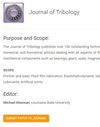基于知识导向的CNN模型在小样本情况下识别相似的三维磨粒
IF 3
3区 工程技术
Q2 ENGINEERING, MECHANICAL
引用次数: 0
摘要
磨损碎片分析(WDA)能够为监测机器故障诊断和分析磨损机理提供重要信息。然而,由于样本数量少且特征高度分散,这种基于经验的技术尚未自动用于识别类似颗粒类型。为了解决这个问题,开发了一个知识引导的卷积神经网络(KG-CNN)模型,以关注两个具有代表性的严重磨损颗粒:疲劳和严重滑动颗粒,它们具有高度相似的轮廓,但具有弱判别性的表面。采用粒子表面的高度图像作为初始目标。以典型粒子特征为特征,将经验WDA知识表示为特征标记的图像,并通过基于U-Net的知识提取网络进行自动学习。通过对U-Net输出进行加权,构建了一个知识引导的粒子分类网络,以识别少量样本下的相似粒子。利用该方法,将经验WDA知识用于指导分类网络定位颗粒高度图像中的判别特征。从磨损试验中获得了30组疲劳和严重滑动颗粒作为训练和测试样本。为了验证,网络内核被可视化以跟踪粒子特征在分类中的传播。实验结果表明,该方法能够准确识别磨损试验中的故障颗粒。本文章由计算机程序翻译,如有差异,请以英文原文为准。
Knowledge-guided CNN Model for Similar 3D Wear Debris Identification with Small Number of Samples
Wear debris analysis (WDA) enables the provision of essential information towards the monitoring of machine fault diagnosis and the analysis of wear mechanism. However, this experience-based technology has not yet been automated for the identification of similar particle types due to the small number of samples and highly-dispersed features. To address this problem, a knowledge-guided convolutional neural network (KG-CNN) model is developed to focus on two representative severe wear particles: fatigue and severe sliding particles that have highly similar contours but weakly discriminative surfaces. The height images of particle surfaces are adopted as the initial objective. Characterized by typical particle features, the empirical WDA knowledge is represented into the feature-marked images, and further automatically learned by a U-Net-based knowledge extraction network. By weighting with the U-Net output, a knowledge-guided particle classification network is constructed to identify similar particles under a small number of samples. With this methodology, the empirical WDA knowledge is transferred to guide the classification network for locating the discriminative features in particle height images. Thirty sets of fatigue and severe sliding particles are acquired from wear tests as the training and testing samples. For verification, the network kernel is visualized to trace the particle feature propagation in the classification. Experimental results reveal that the proposed method can accurately identify fault particles that acquired from wear tests.
求助全文
通过发布文献求助,成功后即可免费获取论文全文。
去求助
来源期刊
CiteScore
4.20
自引率
12.00%
发文量
117
审稿时长
4.1 months
期刊介绍:
The Journal of Tribology publishes over 100 outstanding technical articles of permanent interest to the tribology community annually and attracts articles by tribologists from around the world. The journal features a mix of experimental, numerical, and theoretical articles dealing with all aspects of the field. In addition to being of interest to engineers and other scientists doing research in the field, the Journal is also of great importance to engineers who design or use mechanical components such as bearings, gears, seals, magnetic recording heads and disks, or prosthetic joints, or who are involved with manufacturing processes.
Scope: Friction and wear; Fluid film lubrication; Elastohydrodynamic lubrication; Surface properties and characterization; Contact mechanics; Magnetic recordings; Tribological systems; Seals; Bearing design and technology; Gears; Metalworking; Lubricants; Artificial joints

 求助内容:
求助内容: 应助结果提醒方式:
应助结果提醒方式:


